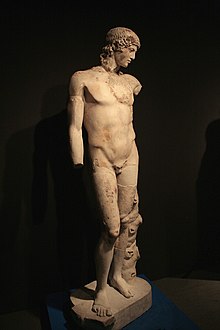Tiber Apollo
| The Tiber Apollo | |
|---|---|
 | |
| Material | Marble |
| Height | 2.04 meters |
| Created | 1st century CE; presumably a copy from 450 BC |
| Discovered | 1891 Ponte Garibaldi, Rome, Italy |
| Present location | Museo Nazionale Romano |
| Culture | Roman |
The Tiber Apollo is an over lifesize[1] marble sculpture of Apollo, a Hadrianic or Antonine Roman marble copy after a bronze Greek original of about 450 BCE.[2] Dredged from the bed of the Tiber in Rome, in making piers for the Ponte Garibaldi (1885, bridge completed 1888).
Found in multiple fragments at the bottom of the river, it is conserved in the Museo Nazionale Romano in Palazzo Massimo alle Terme, Rome. [3][4]
Description
The style of the sculpture reflects the school of Phidias, perhaps the young Phidias himself, as Jiří Frel suggested,[5] and Kenneth Clark observed of it, "If only this figure, instead of the Apollo Belvedere, had been known to Winckelmann, his insight and beautiful gift of literary re-creation would have been better supported by the sculptural qualities of his subject."[6] Of this marble Brian A. Sparkes reminds us that "the general effect of copies always tends towards sweetness, and so it is here."[7]
The figure, with his girlish curls,[8] may once have held the laurel branch and bow, as he is not a citharoedus. The pensive reserve of such Apollos provided the iconographical type for Hadrianic portrait heads of Antinous in the following century.[9] As a patron of the arts, many of the Hadrianic and Nerva–Antonine sculptures sought a softer, more relaxed form of masculinity.[3]
Though it is missing its hand and left arms, the posture of the head and angled shoulder suggests that Apollo was holding something, whether it is a laurel branch or bow. [3]
Another version of the same type was recovered among the ruins of Cherchel, Algeria, the Roman Caesarea Mauretaniae.[10]
A copy was formerly in the Villa Borghese gardens.[11]
See also
- Tiber Dionysus - a life-sized bronze sculpture of Dionysus discovered 6 years earlier in 1885 during construction work on the Ponte Garibaldi
Notes
- ^ 222 cm (7 ft. 3 ¼ in.).
- ^ Brunilde Sismondo Ridgeway (Fifth Century Styles in Greek Sculpture, 1981) suggested that its original, along with many other famous and established models generally dated in the 5th century BCE, should be attributed to a Late Hellenistic classicizing cultural phase of the first centuries BCE/CE;similarly E. Simon (LIMC 2 1984, s.v. "Apollon/Apollo", 373f no. 38) called it an Antonine copy of a classicising Augustan original.
- ^ a b c "Tiber Apollo | Museum of Classical Archaeology Databases". museum.classics.cam.ac.uk. Retrieved 2023-07-23.
- ^ Inv. 608; its rusty staining are the result of its long immersion.
- ^ Frel, "A Hermes by Kalamis and Some Other Sculptures" The J. Paul Getty Museum Journal, 1 (1974:55-60) p. 57, and again in a review of Ridgeway, The Severe Style in Greek Sculpture in The Art Bulletin 56.2, (June 1974:274).
- ^ Clark, The Nude: A Study in Ideal Form, 1956, p.74, illus. p. 75, fig.30.
- ^ Sparkes, "Greek Bronzes" Greece & Rome, Second Series, 34.2 (October 1987:152-168) p 167, illus. fig. 9 p, 166.
- ^ Susan E. Wood. Imperial Women: A Study in Public Images, 40 BC - AD 68 (1999, rev. ed. 2001:225: "The arrangement of hair drawn back over the ears and long shoulder locks appears in statues of both male and female deities, including Apollo"; note 69: Tiber Apollo and other examples.
- ^ Thorsten Opper, Hadrian: Empire and Conflict (2008) makes this point with an illustration of the Tiber Apollo, fig. 162, p. 185 paired with an Antinous.
- ^ LIMC ii. 373 no. 38, s.v. "Apollo"; Christa Landwehr, Die Römische Skulpturen von Caesarea Mauretaniae, vol. II (Idealplastik).
- ^ Illustrated from an old photograph and captioned "lost" by Frel 1974:59, fig. 7.